Tiny technology tapped for oil extraction
ConocoPhillips hopes KU drug delivery method can help get more crude
Kansas University’s efforts to deliver life-saving drugs into cancer-stricken areas now are drilling into another target: the world’s thirst for oil.
KU researchers will receive $1.2 million during the next three years to apply patented drug-delivery nanotechnology to the previously unreachable depths of oil exploration and extraction.
The effort, financed by ConocoPhillips, is designed to boost the efficiency and environmental sensitivity of oil-recovery efforts, including those involving removal of oil from tens of miles below ground.
“ConocoPhillips is pleased to be working with KU to discover some of the next generation of solutions to the world’s energy challenges,” said Stephen Brand, ConocoPhillips senior vice president for technology.
Oil companies still want to find new, untapped reservoirs of oil. And existing technology still allows companies to pump water into long-since-tapped reservoirs to help push even more oil out.
Jenn-Tai Liang, a professor of chemical and petroleum engineering and lead researcher on the project, said present technology can’t get all the oil, leaving plenty of potential petroleum trapped in the pores of rock miles underground.
KU’s nanotechnology aims to change that.
Using the same kind of super-small particles that allow cancer-fighting drugs to be contained until they reach cancer cells in the body, the oil-recovery efforts aim to use such particles to carry agents designed to enable improved oil extraction.
Present technology allows such agents to be contained for only four to six hours, not long enough to reach the deepest of existing oil reservoirs, Liang said. The KU technology contains the agents for up to 60 days.
Such longevity is key, Liang said, because that would allow water to be pumped even deeper below the surface, into targeted areas previously unattainable. The agents would enable blocking of the easiest water routes, therefore sending water into areas where oil still remains.
That would mean less wasted water and more recovered oil.
“We can have a much deeper impact,” he said.
The same nanotechnology also is being applied to chemicals that are used to keep oil pipes clean.
Corrosion can force wells to be closed for as much as three days at a time for chemical treatment, Liang said. By using the nanotechnology to better control the release of active ingredients that fight corrosion, the frequency of shutdowns could be reduced.
“For some of the offshore oil rigs, you’re talking about tens of thousands of barrels of oil a day lost” during shutdowns, he said. “Even at $50 a barrel, that’s a lot of money to save. By reducing the frequency of treatment, you could increase your revenue flow by quite a bit.”
Also working on the project are Cory Berkland, an assistant professor of chemical and petroleum engineering and a courtesy assistant professor of chemistry; and Paul Willhite, a professor of chemical and petroleum engineering.
Liang and Willhite are co-directors of KU’s Tertiary Oil Recovery Project, established in 1974.







